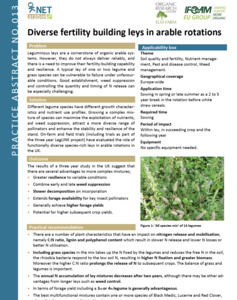{Tool} Diverse fertility building leys in arable rotations (OK-Net Arable Practice Abstract). Creator(s): Bliss, Katie and Measures, Mark. Issuing Organisation(s): ORC - Organic Research Centre. OK-Net Arable Practice abstract, no. 013. (2017)
Preview |
PDF
- English
(Diverse fertility building leys in arable rotations)
268kB |
![[thumbnail of Screenshot 2025-03-12 at 9.24.59 AM.png]](/31040/7.hassmallThumbnailVersion/Screenshot%202025-03-12%20at%209.24.59%E2%80%AFAM.png)  Preview |
Image (PNG)
- Cover Image
- English
900kB |
Document available online at: https://orgprints.org/31040
Summary in the original language of the document
The results of a three year study in the UK suggest that there are several advantages to more complex mixtures;
• Greater resilience to variable conditions
• Combine early and late weed suppression • Slower decomposition on incorporation
• Extends forage availability for key insect pollinators
• Generally achieve higher forage yields
• Potential for higher subsequent crop yields.
Practical recommendation
• There are a number of plant characteristics that have an impact on nitrogen release and mobilisation, namely C:N ratio, lignin and polyphenol content which result in slower N release and lower N losses or better N utilisation.
• Including grass species in the mix takes up the N fixed by the legumes and reduces the free N in the soil; the rhizobia bacteria respond to the low soil N, resulting in higher N fixation and greater biomass. Moreover the higher C:N ratio prolongs the release of N to subsequent crops. The balance of grass and legumes is important.
• The annual N accumulation of ley mixtures decreases after two years, although there may be other advantages from longer leys such as weed control.
• In terms of forage yield including a 3rd or 4th legume is generally advantageous.
• The best multifunctional mixtures contain one or more species of Black Medic, Lucerne and Red Clover, plus other legumes according to the circumstances.
| EPrint Type: | Practice tool |
|---|---|
| What problem does the tool address?: | Leguminous leys are a cornerstone of organic arable systems. However, they do not always deliver reliably, and there is a need to improve their fertility-building capability and resilience. A typical ley of one or two legume and grass species can be vulnerable to failure under unfavourable conditions. Good establishment, weed suppression and controlling the quantity and timing of N release can be especially challenging. |
| What solution does the tool offer?: | Different legume species have different growth characteristics and nutrient use profiles. Growing a complex mixture of species can maximise the exploitation of nutrients, aid weed suppression, attract a more diverse range of pollinators and enhance the stability and resilience of the stand. On-farm and field trials (including trials as part of the three year LegLINK project) have evaluated the role of functionally diverse species-rich leys in arable rotations in the UK. |
| Country: | United Kingdom of Great Britain and Northern Ireland |
| Type of Practice Tool: | Practice abstracts |
| Theme: | Soil quality and fertility, Nutrient management, Pest and disease control, Weed management |
| Keywords: | arable farming, crop rotation, crop species, legumes, nitrogen, nutrient management, pest control, weed management |
| Keywords: | arable farming, crop rotation, crop species, legumes, nitrogen, nutrient management, pest control, weed management, soil quality, plant dosease control |
| Agrovoc keywords: | Language Value URI English arable farming http://aims.fao.org/aos/agrovoc/c_36528 English crop rotation http://aims.fao.org/aos/agrovoc/c_6662 English crops http://aims.fao.org/aos/agrovoc/c_1972 English legumes http://aims.fao.org/aos/agrovoc/c_4255 English nitrogen http://aims.fao.org/aos/agrovoc/c_5192 English nutrient management http://aims.fao.org/aos/agrovoc/c_330697 English pest control http://aims.fao.org/aos/agrovoc/c_5726 English weed control http://aims.fao.org/aos/agrovoc/c_8345 English plant disease control http://aims.fao.org/aos/agrovoc/c_5960 English soil fertility http://aims.fao.org/aos/agrovoc/c_7170 English soil quality http://aims.fao.org/aos/agrovoc/c_a9645d28 |
| Subjects: | Crop husbandry > Production systems > Pasture and forage crops Crop husbandry > Crop combinations and interactions Soil Crop husbandry > Crop health, quality, protection Crop husbandry > Weed management Farming Systems > Farm nutrient management |
| Research affiliation: | European Union > Horizon 2020 > OK-Net Arable > OK-Net-Arable Tools European Union > Horizon 2020 > OK-Net Arable UK > Organic Research Centre (ORC) European Union > Organic Farm Knowledge |
| Horizon Europe or H2020 Grant Agreement Number: | 652654 |
| Related Links: | https://organic-farmknowledge.org/tool/31040, https://organic-farmknowledge.org/tool/44457 |
| Project ID: | ofk |
| Deposited By: | Forschungsinstitut für biologischen Landbau, FiBL |
| ID Code: | 31040 |
| Deposited On: | 18 Jan 2017 14:51 |
| Last Modified: | 12 Mar 2025 08:26 |
| Document Language: | English |
| Status: | Published |
Repository Staff Only: item control page


